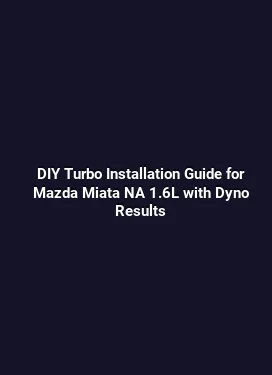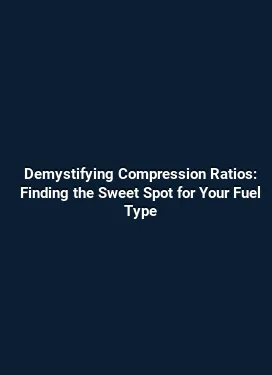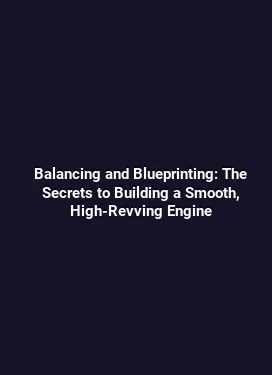Direct Injection vs. Port Injection: Tuning Strategies and Carbon Buildup Solutions
Understanding the Core Differences Between Direct Injection and Port Injection

Engine technology has evolved to unlock greater power, efficiency, and responsiveness. Two prominent fuel delivery architectures in modern performance engines are direct injection (DI) and port injection (PI). Each system places fuel into the intake tract at different stages of the intake and combustion process, which in turn shapes spray characteristics, charge cooling, and combustion stability. A nuanced grasp of how these systems operate lays the groundwork for effective tuning strategies and preventative maintenance practices.
Direct injection programs inject fuel directly into the combustion chamber under high pressure, allowing precise metering and rapid charge cooling. This can enable higher compression ratios and increased boost, translating into stronger power delivery across the rpm range. Port injection, by contrast, introduces fuel into the intake manifold ahead of the intake valve. The fuel has to mix with incoming air in the runner, which can foster better port-to-chamber mixing at moderate loads and temperatures, often contributing to smoother idle, reduced peak cylinder pressures in some setups, and different fuel atomization dynamics.
Why Tuning Strategies Diverge Between DI and PI
Tuning approaches for direct and port injection must account for how each system handles fuel spray, cooling, and mixture formation. For direct injection engines, the main tuning levers revolve around injection timing, dwell, pressure, and the interaction with boosted or high-compression setups. DI engines often require meticulous control to avoid knock, mitigate heat soak, and manage carbon-related phenomena that can develop in the chamber due to altered spray patterns and chamber heat transfer.
Port injection tuning focuses on optimizing air-fuel distribution across cylinders, maintaining stable idle with varying load, and ensuring that fuel vaporization occurs early enough to support consistent combustion. Because fuel is introduced before the intake valve, PI systems can benefit from strategies that improve intake port cooling, throttle response, and throttle body dynamics, particularly at light to mid-load conditions where mixtures must be precisely balanced for efficiency and emissions targets.
Key Parameters Shaping DI Tuning

Injection pressure in DI systems affects atomization quality. Higher pressure generally yields finer droplets, promoting quicker evaporation and charge cooling but also demanding more robust components and careful calibration to avoid over-fueling. Timing events such as spray onset relative to piston position (injection timing) and the duration of the injection event (dwell) are critical for controlling peak pressure, combustion phasing, and torque delivery. In boosted DI engines, the interaction between DI timing and boost pressure becomes a central theme, as late injections can help reduce peak cylinder pressures, while early injections may enhance mixing and mitigate knock under high loads.
Another pivotal factor is piston bowl design and chamber geometry, which influence the trajectory of the DI jet and the formation of fuel-rich zones. Modern tuning often leverages multi-injection strategies (pilot, main, and post injections) to shape the in-cylinder mixture, controlling heat release rates and combustion stability across rpm bands. This is especially important in performance applications where the goal is to maximize power without sacrificing reliability.
Key Parameters Shaping PI Tuning
In port injection systems, air-fuel mixing occurs predominantly in the intake runners. Tuning focuses on achieving uniform distribution to all cylinders, minimizing wall wetting, and ensuring that fuel vaporizes efficiently before the intake valves close. Injector sizing, spray angle, and injector flow characteristics influence the richness of the mixture at various engine speeds. Optimizing throttle response and idle quality often hinges on aligning PI fuel delivery with the engine’s volumetric efficiency curves and the intake tract’s thermal behavior.
Because fuel resides in the intake tract prior to the combustion chamber, port injection can benefit from strategies that promote vaporization during the low- to mid-load ranges. This can include maintaining mild intake temperatures, selecting injector types that produce favorable spray patterns for the runner geometry, and coordinating PI timing with DI in engines that employ a hybrid approach or sequential injection to balance performance with fuel economy and emissions compliance.
Practical Tuning Strategies for Direct Injection Engines
For DI engines, a structured approach to tuning combines hardware capabilities with software calibration. The following strategies emphasize reliability, performance, and drivability across diverse operating conditions.
- Optimize injection timing windows to align with firing order and boost levels. Early injections can promote faster mixture formation, while late injections may help control peak pressures during high-load events.
- Utilize multi-injection schemes to modulate heat release. Pilot injections can reduce knock susceptibility, while main injections deliver the bulk of the charge for peak power.
- Calibrate injection pressure to balance atomization quality with mechanical limits. Higher pressures improve atomization but demand robust fuel system components and cooling strategies for sustained operation.
- Manage cylinder-to-cylinder variability by adjusting individual injector calibration where supported by the ECU. This helps equalize torque delivery and minimizes uneven wear.
- Coordinate DI timing with boost control and intercooling strategies to maintain consistent charge temperature and prevent detonation under aggressive tuning scenarios.
Common DI Challenges and Solutions
A frequent concern with DI setups is carbon buildup on intake valves and in the chamber due to reduced fuel coverage on valve surfaces. Even though fuel is injected directly into the chamber, trace fuels and combustion byproducts can still contribute to deposits through imperfect overall combustion and vapor recirculation behaviors. Solutions include optimizing combustion phasing, ensuring robust ignition performance, and, where applicable, adopting port injection assist or periodic intake cleaning routines. Engine wear and timing chain stability also become focal points as higher-pressure injections intersect with aggressive timing strategies.
Another challenge is fuel injector cleanliness. High-pressure DI injectors are sensitive to fuel quality and contaminants. Regular fuel system maintenance, fuel quality monitoring, and using compatible fuels and additives can help sustain precise spray patterns and consistent fuel delivery over the engine’s life.
Practical Tuning Strategies for Port Injection Engines
Port injection engines emphasize fueling in the intake tract, and tuning them requires attention to mixture quality as the air charge enters the cylinder. The following approaches are particularly effective for PI-based performance builds.
- Balance injector flow across all cylinders to ensure uniform air-fuel ratios. This reduces torque ripple and promotes smoother operation, especially at idle and light loads.
- Leverage throttle-response tuning to align with stall characteristics and drivability. Smooth transitions between idle and low-speed torque improve everyday usability without sacrificing peak power.
- Control wall wetting by optimizing injector spray pattern and port runner geometry. Techniques include adjusting injector positioning and selecting spray types that promote rapid evaporation within the runner.
- Enhance fuel atomization through air speed management in the intake tract. This can involve optimizing intake tract length, runner diameter, and throttle body sizing to support effective misting at target RPM ranges.
- Coordinate PI timing with engine load and rpm to maintain consistent fueling during hot and cold starts, aiding emissions control and catalyst performance.
Addressing Carbon Buildup in PI Systems
While PI systems traditionally exhibit lower carbon buildup within the direct injection chamber, deposits can accumulate on intake valves and ports due to vaporized fuel residues and oil mist carrying fuel components. Regular maintenance intervals, intake cleaning, and monitoring of combustion efficiency help mitigate deposit formation. Strategies include using high-quality fuels, ensuring proper PCV system operation, and employing fuel additives or cleaning regimens designed for intake tract cleanliness when supported by manufacturer guidance.
In some configurations, periodic switchovers to richer or leaner fuel maps at specific RPM ranges can influence deposit formation by altering combustion temperatures and exhaust gas recirculation patterns. Such calibrations should be performed with careful data logging and under controlled conditions to avoid unintended knock or excessive emissions.
Comparative Real-World Scenarios: When to Favor DI or PI Approaches
Selecting between DI or PI strategies is rarely a one-size-fits-all decision. Practical considerations include the intended application, fuel quality, climate, and maintenance expectations. High-performance applications that demand maximum power across a broad rpm range may benefit from DI’s aggressive charge cooling and precise control, especially in boosted builds where knock protection and thermal management are critical. On the other hand, street-driven or endurance-focused applications might favor PI for smoother idle, robust low-to-mid range response, and potentially simpler maintenance due to more forgiving injector dynamics.
Hybrid architectures, which blend DI and PI approaches, are increasingly common in modern performance engines. These configurations leverage the strengths of both systems, providing precise control at high loads while preserving good idle and low-load behavior. Tuning such systems requires coordinated calibration across both injection strategies to ensure harmonious operation and prevent fuel-rich or fuel-lean pockets that could impact performance or longevity.
Flowing Between Maps: How Hybrid Systems Are Calibrated
Hybrid DI/PI setups often implement sequential or blended injection strategies. The calibration challenge centers on the transition regions where PI is supplanted or augmented by DI, or where both systems inject nearly simultaneously. Engineers use fall-back strategies to maintain stable combustion during throttle transitions, high-load bursts, and rapid changes in boost. This requires meticulous ECU programming, accurate sensor feedback, and a thorough understanding of how the intake and combustion dynamics respond to each injection modality under varying ambient conditions.
Maintenance and Longevity: Proactive Practices for High-Performance Engines
Maintenance is a critical pillar of sustaining performance in engines employing DI or PI. Proactive practices help minimize carbon buildup, maintain precise fueling, and extend component life.
- Regular fuel system cleaning and quality fuel selection to reduce contaminants that can impair injector performance and deposit formation.
- Periodic inspection of high-pressure fuel rails, regulators, and seals, particularly in DI systems where pressures are substantially higher and tolerance stacks are tighter.
- Monitoring intake tract cleanliness, especially in engines with aggressive tuning or extended intervals between maintenance. Cleaning of intake runners and valve surfaces may be warranted in high-mileage builds.
- Sensor health checks for MAP, MAF, and oxygen sensors to ensure accurate feedback for fueling and ignition corrections. Sensor drift can lead to maladjusted fueling strategies and efficiency losses.
- Data logging during tuning sessions to verify that fuel trims, air-fuel ratios, and ignition timing stay within safe envelopes across the operating range.
Operating Environment Considerations
Ambient conditions, fuel quality, and maintenance intervals all influence how aggressively a tuning strategy can be pursued. Warmer climates may support higher boost and more aggressive timing, while colder environments require yield-preserving adjustments to avoid misfires and cold-start vulnerabilities. A disciplined approach that pairs data-driven calibrations with routine maintenance yields the most reliable performance gains across daily driving and track use alike.
Trend-Driven Insights: Embracing Semantics That Drive Performance Understanding
In contemporary performance engineering, the interpretation of intake and combustion dynamics benefits from a holistic perspective. Analysts and tuners pay attention to how air charge temperature, fuel evaporation rates, and combustion phasing interact under varying load conditions. By examining the interplay between injection strategies, intake geometry, and exhaust gas recirculation, practitioners can craft calibration curves that deliver coherent power delivery while preserving engine health. This systems-thinking approach helps engineers identify leverage points—such as refining spray timing at specific RPM bands or optimizing port geometry for cleaner vaporization—that yield meaningful gains without compromising reliability.
Closing Thoughts on DI and PI Tuning Journeys
Direct injection and port injection each bring distinct advantages to performance applications. The most successful tuning programs acknowledge the strengths and limitations of each architecture, employing data-driven strategies to optimize spray behavior, mixture formation, and combustion stability. Whether pursuing peak power, refined drivability, or enduring reliability, a structured approach combining precise fueling, thoughtful intake design, and proactive maintenance will empower engines to deliver impressive results across the spectrum of real-world driving scenarios.






